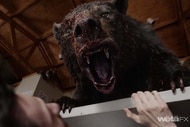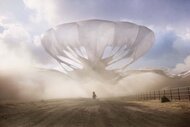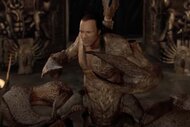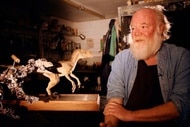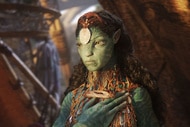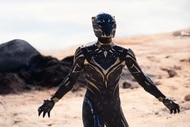Create a free profile to get unlimited access to exclusive videos, sweepstakes, and more!
Emmy Contender: How The Orville's VFX team fought a space battle and Seth MacFarlane broke a ship

Welcome to Emmy Contenders 2019. This month, SYFY WIRE is speaking to a long list of actors, artists, and artisans whose work earned them Emmy nominations this year. Today we speak with VFX producer Brooke Noska and digital effects supervisor Brandon Fayette, nominated for their work on Fox's The Orville.
To prepare for a big production meeting to sell the idea of an epic space battle, The Orville's VFX team did their homework. They studied classic clashes from Star Wars, Star Trek, and Battlestar Galactica, and had all their own camera angles laid out. They had also pre-ordered a fleet of generic toy spaceships from Amazon for the meeting and had 3D printed a few Orville-specific craft as well (a Union fighter). So when the meeting got underway, a full-on space war broke out, with the little demonstration ships being hand-guided through the air while iPhones stood in for cameras. You could almost hear the pew-pews.
"We basically came in with guns loaded, ready to play with all the toys," VFX producer Brooke Noska tells SYFY WIRE. "Brandon was flying little water bottles around." (Brandon Fayette is the show's digital effects supervisor.)
The original script for the Emmy-nominated episode "Identity Part II" called for a two-minute battle, but the VFX team turned its playtime with space toys — sorry, 3-D demonstration with tactile tools — into a previz test that eventually led to a much larger conflict.
"Typically, when we say previz, we mean really rough animation," Fayette says. "With this previz, we treated it like final animation. We made the ships look as if they were real, so we could cut it like real footage."
Fayette admits that he might have gone a little overboard. ("It looked like a giant 3-D film.") But when show creator and star Seth MacFarlane saw this elaborate previz, he was knocked out. "I love this!" he said. "Why don't we do this as a whole battle?" So Fayette dutifully called up Noska and told her, "You know that two-minute scene? It's now 10 minutes."
What MacFarlane loved most about Fayette's previz test was that the action was coherent, which is not always the case in space battles. "You can never really follow what's going on," Fayette says. "I was like, 'Why don't we show people what's happening, from Point A to Point B? Instead of treating the battle like it's just insanity, let them be with us on this journey.'"
In addition to the show's Union ships, the scene also features spacecraft from two alien races — the mechanical Kaylon and the reptilian Krill. The Kaylon, who are set on destroying the Earth, have a whole armada, so the Union and the Krill strike a rare truce and face off against the Kaylon together in the Battle of Earth. (To differentiate the combatants, their laser blasts are color-coded: the Union fighters use blue, the Krill use green, and the Kaylon use red.)
In order to maintain maximum narrative clarity, Fayette uses a lot of camera hand-offs – something not often done in space films, he said. In the Star Wars pictures, for example, we might see the Millennium Falcon attacking other ships, but then the action will cut back to inside the Falcon, and the next time we're outside again, we're looking at a different part of the battle. In the Orville universe, Fayette keeps the tracking clear — if one ship blows up, another flies by and the camera follows that one into the next stretch of action.
Fayette's biggest battle was to complete a finished battle sequence in six weeks. Holed up in a suite at the Ritz Carlton in New York (where MacFarlane was shooting The Loudest Voice at the time), Fayette organized the production chaos with Noska, FuseFX, and Pixomondo on Skype. He kept flowcharts and sketches on whiteboards, including a running tally of who animated the most shots ("I won that") and a list of every single ship involved in the battle (whether or not the ship's name would be visible or even mentioned in the episode). "We went to the writers and [executive producer] David Goodman and said, 'Can you give us 70 names for the ships?'" Fayette recalls. "And they did, and then Fox cleared those 70 names."
Fayette's idea was to map out exactly who was in the battle where, and when exactly individual ships were disabled or destroyed. "You won't see it all, but the ships that are getting blown up, we're tracking them," Fayette says. "Because sometimes, with every shot, I'm picking off a ship like, 'You die here, you die here, you die here.' I had to make sure we didn't blow up the USS Quimby twice."
The VFX team also worked out a plan with the show's science advisor to explain how explosions worked according to each side's technology. Union ships, it had already been established, used quantum core technology, which burned clean energy. ("So when they go, their explosions are warmer," Fayette says.) But Krill technology uses more unclean energy and is less stable. ("So when they blow up, the reactor core goes a lot faster, because it's just all kinds of stuff getting uncontained, and they'll gas out green," Fayette says.) And when the larger Kaylon spheres explode, the result is like a chain reaction, with multiple blasts tearing them apart.
Naturally, Fayette also had to match the action on-set with the CG action, so it would seem fluid. "If the live-action was rock-and-rolling with the crane on the set, and if they did a pan, we'd start with a pan in the CG," he says, "so it's like everything was shot by the same hand. We were doing little nods in our CG filmmaking to match the rhythm of the live-action, which kept the energy up."
Meanwhile, MacFarlane kept tossing out last-minute ideas that created more challenges — like making the Kaylon spheres six times larger and adding nine more ships to fly with the Orville over the moon to the Earth.
MacFarlane also couldn't keep his hands off Fayette's toys — sorry, his beloved seven-inch, hand-painted 3-D Union Fighter ship he was using to block the action. In league with a certain fun-loving guest star (cough, Bruce Willis), MacFarlane managed to break the ship a number of times while playing with it. At first, he tried to apologize. As Fayette recalls, "He was like, 'Brandon? I've got bad news for you. I broke your fighter.' I was like, 'Really? How bad did you break it?' And he was like, 'A bunch of pieces cracked off.' I was like, 'Okay, don't worry about it. I'll fix it.'" And he did.
But when MacFarlane broke the ship again, an irked Fayette retired it to a little box in which it will remain until needed for further service in Season 3 — if then. "They do not get to touch the fighter," he insisted. "No one touches it, ever."
"He's definitely not still bitter about it," Noska says, laughing.

